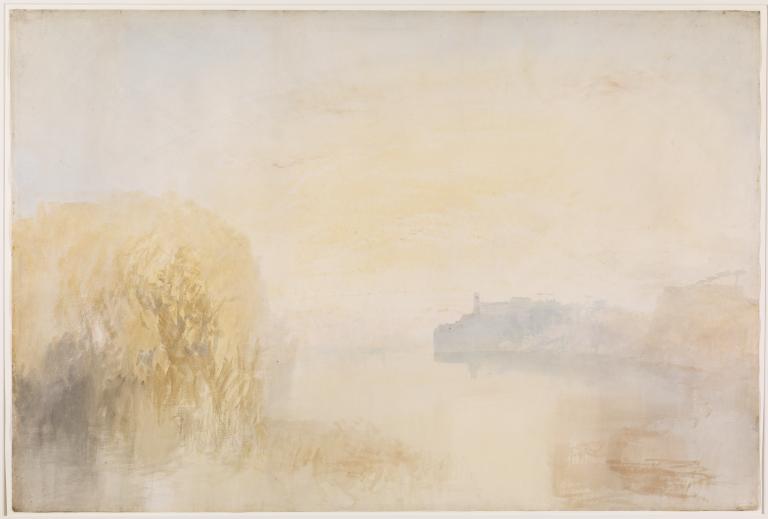Joseph Mallord William Turner Study for 'Rise of the River Stour at Stourhead' c.1824-5
Joseph Mallord William Turner,
Study for 'Rise of the River Stour at Stourhead'
c.1824-5
Joseph Mallord William Turner 1775–1851
Study for ‘Rise of the River Stour at Stourhead’ c.1824–5
D36320
Turner Bequest CCCLXV 29
Turner Bequest CCCLXV 29
Watercolour on white wove paper, 673 x 1005 mm
Watermark ‘J Whatman | Turkey Mill | 1824’
Inscribed in pencil ‘ccclxv.29.’ bottom right
Stamped in black ‘CCCLXV – 29’ bottom right
Watermark ‘J Whatman | Turkey Mill | 1824’
Inscribed in pencil ‘ccclxv.29.’ bottom right
Stamped in black ‘CCCLXV – 29’ bottom right
Accepted by the nation as part of the Turner Bequest 1856
Exhibition history
1966
Turner: Imagination and Reality, Museum of Modern Art, New York, March–May [June] 1966 (84, as ‘Lake with Distant Headland and Palaces’, c.1840).
2000
J.M.W. Turner: The Sun is God, Tate Liverpool, June–October 2000 (40, as ‘Study for “Landscape: Composition of Tivoli”’, c.1817).
2001
William Turner: Licht und Farbe, Museum Folkwang, Essen, September 2001–January 2002, Kunsthaus Zürich, February–May (97, as ‘Composition Study: Landscape with Lake and distant Palaces at Tivoli’, c.1825, reproduced in colour).
2009
Turner / Rothko, Tate Britain, London, March–July 2009 (no catalogue, as ‘Lake, with Distant Headland and Palaces’).
2015
Turner’s Wessex: Architecture and Ambition, Salisbury Museum, May–September 2015 (no number, as ‘Lake with Distant Headland and Palaces; Study for “Rise of the River Stour at Stourhead”’, c.1824–5, reproduced in colour).
References
1830
A.J. Finberg, A Complete Inventory of the Drawings of the Turner Bequest, London 1909, vol.II, p.1213, CCCLXV 29, as ‘Lake, with distant headland and palaces’, after c.1830.
1840
C[harles] Lewis Hind, Turner’s Golden Visions, London and Edinburgh 1910 and 1925, pl.41 (colour), as ‘Lake with Distant Headland and Palaces’, 1840 or after.
1840
Lawrence Gowing, Turner: Imagination and Reality, exhibition catalogue, Museum of Modern Art, New York 1966, p.62 no. 84, as ‘Lake with Distant Headland and Palaces’, c.1840.
1997
Eric Shanes, Turner’s Watercolour Explorations 1810–1842, exhibition catalogue, Tate Gallery, London 1997, pp.29, 93 Appendix I ‘Albano, Lake’, 98 Appendix I ‘Ideal (Italianate) Landscapes’.
1817
Mark Francis and Jonathan Crary, J.M.W. Turner: The Sun is God, exhibition catalogue, Tate Liverpool 2000, p.[106] no.40, as ‘Study for “Landscape: Composition of Tivoli”’, c.1817.
1825
Andrew Wilton in Wilton, Inge Bodesohn-Vogel and Helena Robinson, William Turner: Licht und Farbe, exhibition catalogue, Museum Folkwang, Essen 2001, reproduced in colour p.165, pp.321–2 no.97, as ‘Composition Study: Landscape with Lake and distant Palaces at Tivoli’, c.1825, reproduced in colour.
1824
Ian Warrell, Turner’s Wessex: Architecture and Ambition, exhibition catalogue, Salisbury Museum 2015, pp.39, 200, as ‘Lake with Distant Headland and Palaces; Study for “Rise of the River Stour at Stourhead”’, c.1824–5, fig.31 (colour).
This large, airy ‘colour beginning’ of a golden sky over water was dubbed ‘Lake, with distant headland and palaces’ by Finberg,1 presumably thinking of an idealised Italianate setting like those of Tate D25311 and D25446 (Turner Bequest CCLXIII 189, 323).2 For a while it was associated with the large watercolour Landscape: Composition of Tivoli, dated 1817, exhibited at the Royal Academy in 1818 (private collection),3 and engraved in 1827 (Tate impression: T04502);4 the sheet’s 1824 watermark precludes this, but compare Tate D17191 (Turner Bequest CXCVII A), a colour study which is closely related to the exhibited work.
Suggesting that Turner did originally have Tivoli in mind here too, Andrew Wilton tentatively noted the striking resemblance5 to the watercolour Rise of the River Stour at Stourhead, exhibited at the Royal Academy in 1825 (private collection),6 which has sometimes been regarded as a pendant to the 1817 work.7 Ian Warrell has since made the connection explicit, describing how the ‘Italianate’ light in the Stourhead view ‘had begun as a more diluted, almost sunrise effect’ in this ‘experimental’ study.8 With its prominent sun low over the water towards evening, flanked by classical architecture, the finished design of an English scene evokes Claude Lorrain (1604/5–1682), whom Turner greatly admired and often emulated,9 just as much as the 1817 Composition; however, Eric Shanes has set out various stylistic pointers that indicate that it was likely made shortly before its initial 1825 showing. Assuming a direct preparatory relationship, the present work’s 1824 watermark would confirm this.
The most obvious difference in the finished Stourhead view is the introduction of prominent silhouetted trees across the right-hand third of the composition, as well as a hillside beyond those on the left, and classical garden buildings and a bridge in the foreground and middle distance there. Nevertheless, despite these major differences, the connection seems highly probable. Turner had been visiting the Wiltshire estate of his patron Sir Richard Colt Hoare (1758–1838) since the late 1790s, when he made unresolved colour studies of aspects of the renowned gardens with their picturesquely scattered Gothic follies and classical temples (Tate D01907–D01909; Turner Bequest XLIV e, f, g), as discussed by Wilton in the ‘Architectural Drawings for Commissions c.1797–1800’ subsection under ‘Architectural and Other Subjects c.1797–1807’ elsewhere in this catalogue. Now in the care of the National Trust, Stourhead remains a key example of English landscape garden design informed by antiquarian sensibility and the Grand Tour.
Verso:
Blank; stained, becoming darker towards the right.
Matthew Imms
August 2016
How to cite
Matthew Imms, ‘Study for ‘Rise of the River Stour at Stourhead’ c.1824–5 by Joseph Mallord William Turner’, catalogue entry, August 2016, in David Blayney Brown (ed.), J.M.W. Turner: Sketchbooks, Drawings and Watercolours, Tate Research Publication, March 2017, https://www

